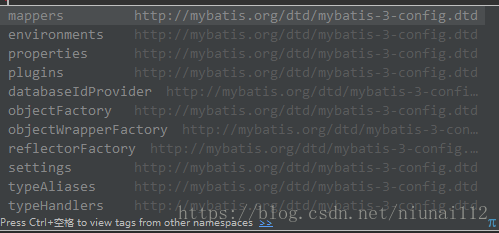SqlSessionFactoryBuilder.build创建SqlSessionFactory(粗略走一步流程)
看完上篇文章后,你对mybatis应该有个大概的了解了,那么我们知道new SqlSessionFactoryBuilder().build是框架的入口,我们到SqlSessionFactoryBuilder类里看到里面其实都是build函数的。
全都是build重载函数。上面几个重载其实最终都是调用了build(Reader reader, String environment, Properties properties)这个方法。下面的几个则是调用了build(InputStream inputStream, String environment, Properties properties) 。
最终都会调用最后一个build(Configuration config)方法,把创建好的Configuration赋给DefaultSqlSessionFactory里面的Configuration字段,所以这里的逻辑其实非常简单,就是解析传入配置文件的Reader或者inputStream,然后生成Configuration,赋值给新建出来的DefaultSqlSessionFactor中的configuration字段,然后返回DefaultSqlSessionFactor。
public class SqlSessionFactoryBuilder {public SqlSessionFactory build(Reader reader) {return build(reader, null, null);}public SqlSessionFactory build(Reader reader, String environment) {return build(reader, environment, null);}public SqlSessionFactory build(Reader reader, Properties properties) {return build(reader, null, properties);}public SqlSessionFactory build(Reader reader, String environment, Properties properties) {try {XMLConfigBuilder parser = new XMLConfigBuilder(reader, environment, properties);return build(parser.parse());} catch (Exception e) {throw ExceptionFactory.wrapException("Error building SqlSession.", e);} finally {ErrorContext.instance().reset();try {reader.close();} catch (IOException e) {// Intentionally ignore. Prefer previous error.}}}public SqlSessionFactory build(InputStream inputStream) {return build(inputStream, null, null);}public SqlSessionFactory build(InputStream inputStream, String environment) {return build(inputStream, environment, null);}public SqlSessionFactory build(InputStream inputStream, Properties properties) {return build(inputStream, null, properties);}public SqlSessionFactory build(InputStream inputStream, String environment, Properties properties) {try {XMLConfigBuilder parser = new XMLConfigBuilder(inputStream, environment, properties);return build(parser.parse());} catch (Exception e) {throw ExceptionFactory.wrapException("Error building SqlSession.", e);} finally {ErrorContext.instance().reset();try {inputStream.close();} catch (IOException e) {// Intentionally ignore. Prefer previous error.}}}public SqlSessionFactory build(Configuration config) {return new DefaultSqlSessionFactory(config);}}
下面,我们来完整的走一个流程,就以上一篇的demo为例
//第一步public static SqlSession getSqlsession(){//获取mybatis,config的xml文件的输入流InputStream config = MybatisUtil.class.getClassLoader().getResourceAsStream("mybatis.cfg.xml");//使用SqlSessionFactory build(InputStream inputStream);来获取SqlSessionFactorySqlSessionFactory build = new SqlSessionFactoryBuilder().build(config);return build.openSession();}//第二步调用SqlSessionFactoryBuilder中的build(InputStream inputStream)方法public SqlSessionFactory build(InputStream inputStream) {return build(inputStream, null, null);}//第三部调用SqlSessionFactoryBuilder中的build(InputStream inputStream, String environment, Properties properties)方法public SqlSessionFactory build(InputStream inputStream, String environment, Properties properties) {try {//把输入流解析成可以用做分析的document,以及准备其他解析需要的东西XMLConfigBuilder parser = new XMLConfigBuilder(inputStream, environment, properties);//parser.parse()生成出Configuration类,最后调用build(Configuration config)方法来生成DefaultSqlSessionFactory,并返回return build(parser.parse());} catch (Exception e) {throw ExceptionFactory.wrapException("Error building SqlSession.", e);} finally {ErrorContext.instance().reset();try {inputStream.close();} catch (IOException e) {// Intentionally ignore. Prefer previous error.}}}//第四步调用SqlSessionFactoryBuilder中的 build(Configuration config) 方法public SqlSessionFactory build(Configuration config) {return new DefaultSqlSessionFactory(config);}
这是最上面的一层,逻辑还是非常简单的,一句话就能概括,就是从给定的配置文件中解析出Configuration,然后生成DefaultSqlSessionFactory。(如果要指定环境,和特定的属性的话用另外2个build 的重载方法)
我们先进入最后一个build看一下,new DefaultSqlSessionFactory(config);究竟做了什么。
public class DefaultSqlSessionFactory implements SqlSessionFactory {private final Configuration configuration;public DefaultSqlSessionFactory(Configuration configuration) {//非常简单,就是生成了一个DefaultSqlSessionFactory 类,然后把里面的configuration字段,赋值为传入的configuration。this.configuration = configuration;}//后面的函数就不列出来了}
build是如何通过xml文件来生成Configuration的(比较详细的分析流程)
所以build的重点在解析xml成Configuration 类这个地方。
也就是下面这两句话
XMLConfigBuilder parser = new XMLConfigBuilder(inputStream, environment, properties);parser.parse();
ok,第一句话是生成了一个XMLConfigBuilder类,我们来看看XMLConfigBuilder到底是什么样的。只列出字段和关键方法
public class XMLConfigBuilder extends BaseBuilder {private boolean parsed;private XPathParser parser;private String environment;private ReflectorFactory localReflectorFactory = new DefaultReflectorFactory();//上层调用到这个方法,然后他调用到了下面的重载方法public XMLConfigBuilder(InputStream inputStream, String environment, Properties props) {//这里只有new XPathParser(inputStream, true, props, new XMLMapperEntityResolver())需要看一下this(new XPathParser(inputStream, true, props, new XMLMapperEntityResolver()), environment, props);}//其实就是给关键的几个字段赋值,这里的第一句调用了父类的构造函数,传入了一个新的Configuration,也就是说到这步的时候,我们用来返回的Configuration对象已经有了,但是Configuration的值还没有构造好。private XMLConfigBuilder(XPathParser parser, String environment, Properties props) {super(new Configuration());ErrorContext.instance().resource("SQL Mapper Configuration");this.configuration.setVariables(props);this.parsed = false;this.environment = environment;this.parser = parser;}}public abstract class BaseBuilder {protected final Configuration configuration;protected final TypeAliasRegistry typeAliasRegistry;protected final TypeHandlerRegistry typeHandlerRegistry;}
接下来我们来看看XPathParser类
public class XPathParser {private Document document;private boolean validation;private EntityResolver entityResolver;private Properties variables;private XPath xpath;public XPathParser(InputStream inputStream, boolean validation, Properties variables, EntityResolver entityResolver) {//为类的其他字段赋值commonConstructor(validation, variables, entityResolver);//根据输入流创建一个Document ,并赋值给 document字段(之后的解析就靠这里面的信息了)this.document = createDocument(new InputSource(inputStream));}}
xml解析成Document的具体过程LZ就不带大家深入研究了,有兴趣的朋友可以自己跟下去看看。
接下来我们回到SqlSessionFactoryBuilder类。
public SqlSessionFactory build(InputStream inputStream, String environment, Properties properties) {//现在我们已经拿到parser了XMLConfigBuilder parser = new XMLConfigBuilder(inputStream, environment, properties);//接下来要去看parse()是怎么创建出Configuration的return build(parser.parse());} catch (Exception e) {throw ExceptionFactory.wrapException("Error building SqlSession.", e);} finally {ErrorContext.instance().reset();try {inputStream.close();} catch (IOException e) {// Intentionally ignore. Prefer previous error.}}}public Configuration parse() {if (parsed) {throw new BuilderException("Each XMLConfigBuilder can only be used once.");}parsed = true;//解析靠这步,首先拿到configuration节点parseConfiguration(parser.evalNode("/configuration"));return configuration;}public XNode evalNode(String expression) {return evalNode(document, expression);}public XNode evalNode(Object root, String expression) {//拿到configuration节点Node node = (Node) evaluate(expression, root, XPathConstants.NODE);if (node == null) {return null;}//返回封装成XNode类return new XNode(this, node, variables);}
public class XNode {private Node node;private String name;private String body;private Properties attributes;private Properties variables;private XPathParser xpathParser;public XNode(XPathParser xpathParser, Node node, Properties variables) {this.xpathParser = xpathParser;this.node = node;this.name = node.getNodeName();this.variables = variables;this.attributes = parseAttributes(node);this.body = parseBody(node);}
}
XPathParser类的实际值
封装好的Xnode的实际值
//接下来就要解析并给configuration赋值拉。因为configuration在新建XMLConfigBuilder的时候就已经创建好了,解析的过程其实就是赋值的过程(我们在xml文件里配置的各个节点都在下面这个函数里解析)
private void parseConfiguration(XNode root) {try {//issue #117 read properties firstpropertiesElement(root.evalNode("properties"));Properties settings = settingsAsProperties(root.evalNode("settings"));loadCustomVfs(settings);typeAliasesElement(root.evalNode("typeAliases"));pluginElement(root.evalNode("plugins"));objectFactoryElement(root.evalNode("objectFactory"));objectWrapperFactoryElement(root.evalNode("objectWrapperFactory"));reflectorFactoryElement(root.evalNode("reflectorFactory"));settingsElement(settings);// read it after objectFactory and objectWrapperFactory issue #631environmentsElement(root.evalNode("environments"));databaseIdProviderElement(root.evalNode("databaseIdProvider"));typeHandlerElement(root.evalNode("typeHandlers"));mapperElement(root.evalNode("mappers"));} catch (Exception e) {throw new BuilderException("Error parsing SQL Mapper Configuration. Cause: " + e, e);}}
这是xml文件中要的标签,和上面代码一对比,你就会清楚的明白,上面每一个方法其实就是把每一个标签转换成configuration。
private void propertiesElement(XNode context) throws Exception {if (context != null) {//从子属性直接获取属性的键值对Properties defaults = context.getChildrenAsProperties();//从外部引入属性文件(其实就是获取resource属性的值)String resource = context.getStringAttribute("resource");//也可以从url下获取属性文件(引入网络路径或者磁盘路径下的资源)String url = context.getStringAttribute("url");if (resource != null && url != null) {throw new BuilderException("The properties element cannot specify both a URL and a resource based property file reference. Please specify one or the other.");}//从resource 或者 url的属性文件中加载键值对,若和上面的defaults,键相同则替换defaults中的if (resource != null) {defaults.putAll(Resources.getResourceAsProperties(resource));} else if (url != null) {defaults.putAll(Resources.getUrlAsProperties(url));}Properties vars = configuration.getVariables();if (vars != null) {defaults.putAll(vars);}//设置parser的Variablesparser.setVariables(defaults);//设置configuration的Variablesconfiguration.setVariables(defaults);}}其他的解析其实和properties的解析差不多。根据配置文件节点的信息设置configuration。
因为mybatis非常重要的一个点就是在mapper上,所以楼主之后会有一篇专门写mapper是什么解析和使用的。所以这里大家可以简单过一下mapper的解析过程。
private void mapperElement(XNode parent) throws Exception {if (parent != null) {for (XNode child : parent.getChildren()) {if ("package".equals(child.getName())) {String mapperPackage = child.getStringAttribute("name");configuration.addMappers(mapperPackage);} else {String resource = child.getStringAttribute("resource");String url = child.getStringAttribute("url");String mapperClass = child.getStringAttribute("class");if (resource != null && url == null && mapperClass == null) { //根据resource解析ErrorContext.instance().resource(resource);InputStream inputStream = Resources.getResourceAsStream(resource);XMLMapperBuilder mapperParser = new XMLMapperBuilder(inputStream, configuration, resource, configuration.getSqlFragments());mapperParser.parse();} else if (resource == null && url != null && mapperClass == null) {//根据url 解析ErrorContext.instance().resource(url);InputStream inputStream = Resources.getUrlAsStream(url);XMLMapperBuilder mapperParser = new XMLMapperBuilder(inputStream, configuration, url, configuration.getSqlFragments());mapperParser.parse();} else if (resource == null && url == null && mapperClass != null) {//根据mapperClass解析Class<?> mapperInterface = Resources.classForName(mapperClass);configuration.addMapper(mapperInterface);} else {throw new BuilderException("A mapper element may only specify a url, resource or class, but not more than one.");}}}}}
套路其实差不多,就不细细的深入看了。但是mybatis的mapper的实现方法还是要细细讨论的,让我们在之后的文章中在细致的学习以下。
小结
看了加载过程的源码,我们在这至少了解到了mybatis是如何解析xml文件的,还有properties,假如我们即在xml文件中直接配置的属性和又设置了resource(或者url)的话,resource(或者url)中的属性会覆盖xml文件中直接配的(key相同的情况下才会覆盖,否则是累加的情况),若详细看过mapper的创建过程的话,还会知道在xml中配的mapper的语句会被注解中配置的语句覆盖。为什么会有这些特性?因为源码的读取步骤以及策略如此,所以要善于利用




mapper接口底层原理(为什么不用写方法体就能访问到数据库))

mapper访问数据库的底层原理(代理方法中具体访问数据库的细节))

mybatis拦截器(Interceptor)的实现原理)
Mybatis一级缓存和二级缓存的实现)

方法)










方法实例)